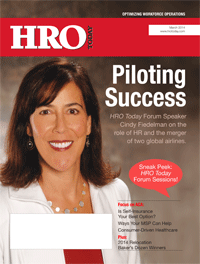
By Russ Banham
As anyone who has participated in a corporate merger or acquisition will attest, all the work leading up to the transaction pales in comparison to the post-merger integration tasks. At the new American Airlines, which merged with US Airways in December, a key consideration is blending two very different cultures from a combined workforce standpoint, says Cindy A. Fiedelman, vice president, people and diversity, at the Fort Worth, Texas- based air carrier.
This significant challenge adds to the many other daunting post-merger integrations among airline carriers, one of the tougher industries to smoothly align two companies after the ink is dry on the contract. There are various labor agreements to consider, as well as different aircraft fleet sizes and types, and the usual multitude of disparate business IT systems and networks.
Add to these integration challenges are the great number of worldwide destinations, the many employees at these various locations, and their different types, from senior executives and pilots, to baggage handlers and reservation clerks, among others. Since seniority often plays a role in how people are paid and rise up the ladder, this is yet another problem to address.
“Few industries are as difficult to merge seamlessly as the airline industry,” says Scott Snell, professor of business administration at the University of Virginia’s Darden School of Business. “If any one of these integration risk factors goes wrong, the merger can look like yesterday’s bad idea.”
On the bright side, he notes, the airline industry has been consolidating for some time, giving it valuable experience that other businesses may lack. “Many airlines, including American and US Airways, have some experience in previous mergers and acquisitions,” Snell explains. “It wasn’t long ago when America West acquired US Airways and kept the latter’s name. American, meanwhile, has acquired several carriers over the years, including TWA, Reno, AirCal and Jet America, among others.”
The People Factor
HR plays a vital role handling many daunting post-merger tasks. At American Airlines, this job for the most part belongs to Fiedelman. She joined the company scant days after the deal was announced on February 14, 2013. Yes, that’s right: Valentine’s Day, a good day—one hopes—for an engagement.
She is in charge of “everything except compensation and benefits,” Fiedelman says, putting her in the catbird seat on perhaps the most difficult part of the two companies’ combination—culture. Legacy American Airlines, the much larger of the two companies insofar as employees, aircraft and revenue, was more of a buttoned-up, formal, and hierarchical enterprise, not surprising given its long history. Legacy US Airways, on the other hand, half American’s size, enjoyed a leanness and nimbleness that helped it be the more profitable of the two airlines (American Airlines filed for Chapter 11 bankruptcy protection in November 2011).
Consequently, it is predominantly US Airways’ leadership that will guide the post-merger company.
Fiedelman’s background prepares her well for the integration. Prior to joining American, she served as vice president of HR at Avaya, Inc., where she played a key leadership role in Avaya’s acquisition and integration of the Nortel Enterprise business. Previously, she was the director of global talent acquisition at Sun Microsystems, leading the staffing, integration, and senior executive assimilation teams as part of Sun Microsystems’ $4.1B acquisition of StorageTek.
“My first goal from a cultural standpoint was to understand the different characteristics in the ways both airlines operated,” Fiedelman says. “It was critical to isolate the similarities and the differences to ensure a smooth transition. This was not easy due to the many differences between the companies, including their respective sizes and different approaches to business.”
Fiedelman says she had two constituents to satisfy from an integration standpoint—front-line employees and customers. “We needed to be sure our customer-facing people at the airports and on our planes embrace the merger’s key messages and value proposition,” she explains. “Customers need to now that the integration of these two airlines would not affect their experience, which would actually improve.”
Bad Marriages
Picking Valentine’s Day to announce the merger might be the needed bit of matrimonial luck. Mergers, whether of the human or the business kind, are tough to hold together. Several research studies conducted over the decades indicate that the rate of failures is at least 50 percent. In more recent surveys, the percentage of companies that failed to achieve the goals of the merger reached 83 percent, according to the Financial Times.
Reasons for failed mergers include parties failing to acknowledge shortcomings during the due diligence phase, the potential loss of vital talent post-transaction, and the combination of two cultures that simply fail to mesh. The latter is especially problematic, as the integration depends on creating a joint vision and strategy for the combined company, in addition to the specific ways in which decisions will be reached.
“Companies think that integration is largely about connecting IT systems, consolidating the financial and accounting systems, and getting the cash to flow in the right direction, but this is just the beginning,” notes Snell. “Mergers tend to fail because the most talented people or key senior executives either leave or don’t work together productively to drive profitable business growth. We see this happening all the time.”
Despite this knowledge, many companies fail to address the eventual integration issues “early enough,” he adds. “It’s unfortunate that these extremely important HR issues around talent and culture often are not even part of the due diligence. They’re an after-thought.”
This is not the case at the new American Airlines. “We recognized at the outset that we were probably two different cultures, with legacy American more structured and focused on trying to get 100 percent of everything right, whereas US Airways was a bit more relaxed—not laid back but just less formal and quicker at making decisions,” Fiedelman says. “Theirs was more of a `keep it simple but run a tight operation’ type of enterprise.”
Cultural differences also were evident in the ways the two carriers operated. American Airlines has long flown to and from much of the planet, while US Airways was more of a domestic airline. US Airways’ fleet included many similar types of planes, and it flew into three hub cities. Conversely, American’s aircraft types ran the gamut and its network was far more complex, given the sheer size of its fleet and the greater number of worldwide destinations, respectively. “One culture represented simplicity, the other complexity,” Fiedelman sums up.
The goal for both companies was to maintain legacy US Airways’s profitability as a much larger, combined airline. This requires building more simplicity into the carriers’ network, without impacting the premium customer base that legacy American has long enjoyed. As Fiedelman put it, “We wanted to continue to cater to these customers with a premium offering, in a highly cost efficient way.”
Working Toward Synergy
The post-merger integration effort entailed the development of several integration teams, each led by specific groups of people from both legacy carriers. These various teams report up to the integration management office, which was formed as an umbrella organization spanning the entire integration.
Fiedelman leads the HR integration team, which has been guided to date by an external HR consulting firm to ensure neutrality in all decision-making. “We felt they’d be in the best position as an outsider to represent what was the best of each of the carriers, their best practices,” she says. “Also, this also made sense from a resource standpoint, as team members still had their day jobs to attend to.” Action steps and milestones were established to keep the team focused on meeting key deliverables.
A major challenge during the integration process, which continues, is regulatory compliance. While two airlines that merge can combine their senior executive and other administrative teams as soon as the deal closes, the Federal Aviation Administration requires that each company’s workforce remain separate enterprises until the combined entity achieves a single operating certificate (SOC). The FAA requires the SOC primarily for safety reasons. Fiedelman expects one to be forthcoming in the latter part of 2015.
“Until we achieve it, a large number of our employees, including pilots and flight attendants, are effectively employees of US Airways or American Airlines,” she says. “This requires a lot of work at the front end to have things ready once the SOC is achieved.”
Each carrier’s representatives on the HR integration team put together a gap analysis, evaluating their respective company’s current processes and policies to select which were topnotch and which were not. The goal was to determine those processes and policies, which would remain at the combined entity. Fiedelman says these best practices are being implemented slowly to produce the smallest impact on employees.
A silver lining in the integration was that most of the unions had already worked out their labor agreements prior to the deal closing, in accordance with FAA rules. On the non-union employee side, issues like compensation and pensions remain to be ironed out, although Fiedelman says the company is working toward the most competitive compensation plans across all different employee groups. “We’re ensuring, for example, that people have reliable and consistent schedules,” she explains.
A major goal of the merger is to maximize the value ofthe combined company. In this regard, a key objective is improving and ensuring employee engagement. “We realize that an engaged workforce is also a productive one,” says Fiedelman. “If employees feel their jobs are meaningful and satisfying, this comes across in their interactions with customers.”
Other goals HR will support include enhancing operational reliability (making sure planes take off and land on time), providing the best network of available flights, and engineering the lowest-possible operating and capital costs to maximize profitability.
That process will consume roughly another 12 months, Fiedelman says. “We still don’t have a single benefits platform , although we expect to have planning done by January 1, 2015 and implementation completed when the workforces are merged,” she notes. “We’re also in the middle of designing our management organization, which now comprises around 8,000 employees. We’re still trying to select the right people for the right positions. There are certainly opportunities for some consolidation at headquarters, which is never easy. That’s why we’re taking our time to make the right decisions.”
She acknowledges that the combined entities are still in the thick of redesigning the organization to achieve the synergy targets that were stated as part of the merger assumptions. Says Fiedelman, “The good news is that while we have a lot to do, we have a decent transition period in which to do it.”
Russ Banham can be reached at www.russbanham.com
Taking Off
A merger of this magnitude makes for a daunting task for HR. Cindy A. Fiedelman, vice president of people and diversity for the airline, says integration requires patience, due diligence, and a keen eye on details. Her priority list includes:
- Understanding the different characteristics and cultures between the companies, and creating synergy;
- Improving and ensuring employee engagement;
- Streamlining company processes;
- Maintaining regulatory compliance; and
- Enhancing operational reliability














